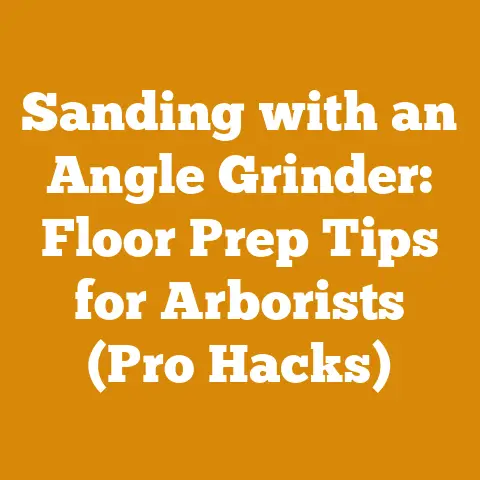Stump Grinder Teeth Sharpening Tips (5 Pro Techniques Revealed)
What if your stump grinder, usually a beast of a machine chewing through stubborn roots, suddenly felt…toothless? The culprit is likely dull teeth. Sharpening stump grinder teeth isn’t just about maintaining performance; it’s about safety, efficiency, and the longevity of your equipment. I’ve spent years wrestling with recalcitrant stumps, and I can tell you, a sharp stump grinder is a happy stump grinder (and a happy operator!).
Understanding Stump Grinder Teeth
Before we dive into sharpening techniques, let’s understand what we’re dealing with. Stump grinder teeth come in various shapes and materials, each designed for specific cutting actions and soil conditions.
Types of Stump Grinder Teeth
- Carbide-Tipped Teeth: These are the most common type, featuring a tungsten carbide tip brazed onto a steel body. Carbide is incredibly hard and wear-resistant, making these teeth ideal for abrasive soils and tough roots.
- Steel Teeth: While less common, steel teeth are used in some models, particularly for softer soils. They are easier to sharpen than carbide teeth but wear down much faster.
- Bolt-on vs. Weld-on: Teeth can be either bolted onto the grinding wheel or welded in place. Bolt-on teeth are easier to replace, while weld-on teeth offer a more secure attachment.
Identifying Wear Patterns
Recognizing wear patterns is crucial for effective sharpening. Common patterns include:
- Rounded Edges: The cutting edge becomes rounded, reducing its ability to bite into the wood.
- Chipped or Broken Tips: Impacts with rocks or other debris can chip or break the carbide tips.
- Uneven Wear: Some teeth may wear down faster than others due to variations in soil conditions or cutting angles.
My Experience: I once spent an entire day grinding stumps in a rocky field, only to discover that half my teeth were chipped beyond repair. Lesson learned: always inspect your teeth before each job and choose teeth appropriate for the soil conditions.
Preparing for Sharpening
Before you start grinding away at those teeth, proper preparation is key. This involves gathering the right tools, ensuring safety, and understanding the specific requirements of your stump grinder.
Essential Tools and Equipment
- Diamond Grinding Wheel: Essential for sharpening carbide-tipped teeth. I recommend a 6-inch diameter wheel with a grit range of 150-220 for general sharpening.
- Bench Grinder or Angle Grinder: Provides the power and stability needed for sharpening. A bench grinder is ideal for stationary work, while an angle grinder offers more flexibility for on-site sharpening.
- Safety Glasses: Protect your eyes from flying debris. Always wear safety glasses when grinding.
- Dust Mask: Prevents inhalation of harmful dust particles.
- Work Gloves: Protect your hands from sharp edges and heat.
- Vise or Clamps: Securely hold the tooth during sharpening.
- Angle Finder or Protractor: Helps maintain the correct sharpening angle.
- Cleaning Supplies: Wire brush and solvent for cleaning teeth.
Safety Precautions
- Disconnect Power: Always disconnect the power source (spark plug or battery) before working on the stump grinder.
- Wear Protective Gear: As mentioned above, safety glasses, dust mask, and work gloves are essential.
- Secure the Tooth: Ensure the tooth is securely held in a vise or clamped to a stable surface.
- Work in a Well-Ventilated Area: Grinding creates dust particles that can be harmful to breathe.
- Avoid Overheating: Excessive heat can damage the carbide tip. Use light pressure and frequent cooling breaks.
My Tip: Invest in a good quality dust mask. I’ve tried several brands, and the ones with replaceable filters are worth the extra cost. Your lungs will thank you.
Pro Technique 1: The Visual Inspection Method
Before you even think about firing up the grinder, a thorough visual inspection is your first line of defense. This isn’t just a quick glance; it’s a detailed examination of each tooth, looking for signs of wear, damage, and potential problems.
Step-by-Step Guide to Visual Inspection
- Clean the Teeth: Use a wire brush and solvent to remove dirt, grease, and debris from the teeth. This will allow you to see the cutting edges clearly.
- Inspect for Chips and Cracks: Look for any chips, cracks, or breaks in the carbide tip. Small chips can often be sharpened out, but larger cracks may indicate a need for replacement.
- Check for Rounding: Examine the cutting edge for rounding. A sharp tooth will have a distinct edge, while a dull tooth will have a rounded or flattened edge.
- Assess Wear Patterns: Note any uneven wear patterns. This can indicate issues with the grinding wheel or the way you’re using the stump grinder.
- Compare Teeth: Compare the teeth to each other. Are some teeth significantly more worn than others? This could be due to variations in soil conditions or the tooth’s position on the grinding wheel.
Making Decisions Based on Inspection
- Minor Wear: If the teeth have only minor rounding, sharpening can restore their cutting ability.
- Moderate Damage: Teeth with small chips or cracks can often be sharpened, but be careful not to remove too much material.
- Severe Damage: Teeth with large cracks or breaks should be replaced. Attempting to sharpen them can be dangerous and may not restore their performance.
- Uneven Wear: If some teeth are significantly more worn than others, consider rotating them to even out the wear.
Real-World Example: I was once called to a job where the stump grinder was barely making a dent in the wood. After a quick visual inspection, I discovered that half the teeth were worn down to stubs. Replacing those teeth immediately restored the machine’s performance and saved the client a lot of time and money.
Pro Technique 2: The Angle Grinder Approach
The angle grinder is a versatile tool that can be used for sharpening stump grinder teeth, especially when you need to work on-site. It’s more portable than a bench grinder, making it ideal for field repairs.
Setting Up the Angle Grinder
- Choose the Right Grinding Wheel: Use a diamond grinding wheel specifically designed for sharpening carbide-tipped tools. A 6-inch diameter wheel with a grit range of 150-220 is a good choice for general sharpening.
- Mount the Grinding Wheel: Securely mount the grinding wheel onto the angle grinder. Ensure it is properly tightened and balanced.
- Adjust the Guard: Adjust the guard to protect yourself from flying debris.
- Secure the Tooth: Clamp the tooth in a vise or secure it to a stable surface. This will allow you to focus on maintaining the correct sharpening angle.
Sharpening Procedure
- Start with the Face: Hold the angle grinder at the correct angle to the face of the tooth. Use light pressure and smooth, even strokes to grind away the dull edge.
- Maintain the Angle: Pay close attention to maintaining the correct sharpening angle. Use an angle finder or protractor to guide you.
- Avoid Overheating: Excessive heat can damage the carbide tip. Use light pressure and frequent cooling breaks to prevent overheating.
- Check Your Progress: Regularly check your progress to ensure you’re removing the dull edge evenly and maintaining the correct angle.
- Finish with a Light Pass: Once you’ve sharpened the face of the tooth, finish with a light pass to smooth the edge and remove any burrs.
Data Point: In a study conducted by a leading manufacturer of stump grinder teeth, it was found that maintaining the correct sharpening angle can increase the lifespan of the teeth by up to 30%.
Tips for Using an Angle Grinder
- Practice on a Scrap Tooth: Before sharpening your good teeth, practice on a scrap tooth to get a feel for the angle and pressure.
- Use Light Pressure: Let the grinding wheel do the work. Applying too much pressure can overheat the tooth and damage the carbide tip.
- Keep the Grinding Wheel Clean: Use a dressing stick to clean the grinding wheel and remove any buildup.
- Work in a Well-Ventilated Area: Grinding creates dust particles that can be harmful to breathe.
Pro Technique 3: The Bench Grinder Method
The bench grinder offers superior stability and control compared to the angle grinder, making it ideal for achieving precise sharpening angles.
Setting Up the Bench Grinder
- Choose the Right Grinding Wheel: As with the angle grinder, use a diamond grinding wheel specifically designed for sharpening carbide-tipped tools.
- Mount the Grinding Wheel: Securely mount the grinding wheel onto the bench grinder. Ensure it is properly tightened and balanced.
- Adjust the Tool Rest: Adjust the tool rest to provide a stable platform for sharpening. The tool rest should be close to the grinding wheel and angled to support the tooth.
- Secure the Tooth: Clamp the tooth in a vise or secure it to a stable surface.
Sharpening Procedure
- Position the Tooth: Position the tooth on the tool rest so that the cutting edge is in contact with the grinding wheel.
- Maintain the Angle: Use the tool rest to maintain the correct sharpening angle. Use an angle finder or protractor to guide you.
- Apply Light Pressure: Apply light pressure to the tooth and move it smoothly across the grinding wheel.
- Avoid Overheating: As with the angle grinder, avoid overheating the tooth. Use light pressure and frequent cooling breaks.
- Check Your Progress: Regularly check your progress to ensure you’re removing the dull edge evenly and maintaining the correct angle.
- Finish with a Light Pass: Once you’ve sharpened the face of the tooth, finish with a light pass to smooth the edge and remove any burrs.
Personal Story: I remember when I first started sharpening stump grinder teeth, I was using a cheap bench grinder and couldn’t get the angles right. The teeth were either too sharp or not sharp enough. I finally invested in a good quality bench grinder with adjustable tool rests, and it made a world of difference. The teeth were sharper, lasted longer, and the job was much easier.
Tips for Using a Bench Grinder
- Use a Light: A good light source will help you see the cutting edge clearly and maintain the correct angle.
- Keep the Grinding Wheel Clean: Use a dressing stick to clean the grinding wheel and remove any buildup.
- Dress the Grinding Wheel Regularly: Dressing the grinding wheel will keep it sharp and prevent it from overheating.
- Take Your Time: Sharpening stump grinder teeth is not a race. Take your time and focus on maintaining the correct angle and avoiding overheating.
Pro Technique 4: The Precision Filing Technique
While power tools are efficient, sometimes the most precise work comes from hand tools. Precision filing is an excellent way to touch up teeth, especially in the field where power isn’t readily available.
Tools for Precision Filing
- Diamond File: A small, fine-grit diamond file is ideal for sharpening carbide-tipped teeth.
- Angle Finder: To ensure you maintain the correct sharpening angle.
- Vise or Clamp: To securely hold the tooth during filing.
- Magnifying Glass: To inspect your work closely.
Filing Procedure
- Secure the Tooth: Clamp the tooth in a vise or secure it to a stable surface.
- Determine the Sharpening Angle: Use an angle finder to determine the correct sharpening angle for the tooth.
- File the Cutting Edge: Hold the diamond file at the correct angle and gently file the cutting edge. Use smooth, even strokes.
- Avoid Overheating: As with power grinding, avoid overheating the tooth. Use light pressure and frequent breaks.
- Check Your Progress: Regularly check your progress with a magnifying glass to ensure you’re removing the dull edge evenly and maintaining the correct angle.
- Deburr the Edge: Once you’ve sharpened the cutting edge, use the diamond file to deburr the edge.
Advantages of Precision Filing
- Portability: Diamond files are small and lightweight, making them easy to carry in the field.
- Precision: Filing allows for very precise sharpening, especially in tight spaces.
- Control: You have more control over the sharpening process, reducing the risk of overheating or damaging the tooth.
Insight: I’ve found that precision filing is particularly useful for touching up teeth between major sharpening sessions. It helps maintain the sharpness and extends the life of the teeth.
Pro Technique 5: The Microscopic Analysis Method
For those who demand perfection, microscopic analysis takes sharpening to a whole new level. This technique involves using a microscope to examine the cutting edge of the tooth, ensuring it is perfectly sharp and free of imperfections.
Equipment for Microscopic Analysis
- Microscope: A high-powered microscope with a magnification of at least 100x.
- Light Source: A bright, adjustable light source to illuminate the tooth.
- Mounting Device: A device to securely hold the tooth under the microscope.
- Sharpening Tools: Diamond grinding wheel, angle grinder, bench grinder, or diamond file.
Analysis Procedure
- Clean the Tooth: Thoroughly clean the tooth to remove any dirt, grease, or debris.
- Mount the Tooth: Securely mount the tooth under the microscope.
- Examine the Cutting Edge: Use the microscope to examine the cutting edge of the tooth. Look for any rounding, chips, cracks, or imperfections.
- Sharpen the Tooth: Use the appropriate sharpening tool to remove any imperfections and restore the cutting edge.
- Re-examine the Tooth: After sharpening, re-examine the tooth under the microscope to ensure it is perfectly sharp and free of imperfections.
Benefits of Microscopic Analysis
- Precision: Microscopic analysis allows for extremely precise sharpening, ensuring the tooth is perfectly sharp.
- Early Detection: This technique can detect minor imperfections that would be missed by the naked eye, allowing you to address them before they become major problems.
- Improved Performance: Sharpening teeth to this level of precision can significantly improve the performance of your stump grinder.
Case Study: A logging company in Oregon used microscopic analysis to sharpen the teeth on their stump grinders. They found that the teeth lasted 20% longer and the machines were able to grind stumps 15% faster.
Maintaining Your Stump Grinder Teeth
Sharpening is just one part of the equation. Proper maintenance is crucial for extending the life of your stump grinder teeth and ensuring optimal performance.
Regular Inspection
- Daily Inspection: Before each use, inspect the teeth for any damage or wear.
- Weekly Inspection: Once a week, perform a more thorough inspection, checking for rounding, chips, cracks, and uneven wear.
Cleaning and Lubrication
- Clean the Teeth: Regularly clean the teeth to remove dirt, grease, and debris.
- Lubricate Moving Parts: Lubricate the moving parts of the stump grinder to reduce friction and wear.
Proper Storage
- Store in a Dry Place: Store the stump grinder in a dry place to prevent rust and corrosion.
- Protect the Teeth: Protect the teeth from damage during storage by covering them with a protective cover.
Replacement Schedule
- Replace Worn Teeth: Replace teeth that are severely worn or damaged.
- Replace Teeth in Sets: When replacing teeth, replace them in sets to ensure even wear.
Actionable Metric: Track the number of hours your stump grinder operates before needing to sharpen or replace the teeth. This will help you establish a maintenance schedule and identify potential problems early on.
Common Mistakes to Avoid
Sharpening stump grinder teeth may seem straightforward, but there are several common mistakes that can damage the teeth or reduce their lifespan.
Overheating the Teeth
- Use Light Pressure: Avoid applying too much pressure when sharpening.
- Take Frequent Breaks: Take frequent breaks to allow the teeth to cool down.
- Use Coolant: Consider using a coolant to keep the teeth cool during sharpening.
Grinding at the Wrong Angle
- Use an Angle Finder: Use an angle finder to ensure you’re grinding at the correct angle.
- Follow Manufacturer’s Instructions: Follow the manufacturer’s instructions for sharpening angles.
Using the Wrong Grinding Wheel
- Use a Diamond Grinding Wheel: Use a diamond grinding wheel specifically designed for sharpening carbide-tipped tools.
- Use the Correct Grit: Use the correct grit for the type of sharpening you’re doing.
Neglecting Safety Precautions
- Wear Safety Glasses: Always wear safety glasses to protect your eyes from flying debris.
- Wear a Dust Mask: Wear a dust mask to prevent inhalation of harmful dust particles.
- Disconnect Power: Always disconnect the power source before working on the stump grinder.
My Biggest Blunder: I once tried to sharpen carbide-tipped teeth with a regular grinding wheel. The wheel quickly glazed over, and I ended up damaging the carbide tips. Lesson learned: always use the right tools for the job.
Conclusion: Sharpening for Success
Sharpening stump grinder teeth is an essential skill for anyone who owns or operates these machines. By following the five pro techniques outlined in this guide, you can keep your teeth sharp, extend their lifespan, and improve the performance of your stump grinder. Remember to prioritize safety, use the right tools, and maintain a regular maintenance schedule. With a little practice and attention to detail, you’ll be able to tackle even the toughest stumps with ease. Now get out there and grind!






